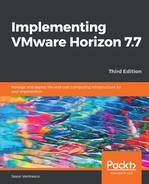Maintaining desktops, or Windows RDS servers that are deployed using VMware Horizon, requires a different approach depending on what type of desktop you have selected. Full-clone desktops are typically managed using the same techniques as traditional physical desktops, as each is a fully independent virtual machine with dedicated underlying virtual hard disks. Many organizations choose full-clone desktops for this reason, as they can continue to manage them using tools and procedures that are already in place.
Linked-clone desktops are an entirely different matter, especially if you wish to minimize the amount of per-desktop storage that is required. If an organization were to manage its linked-clone desktops using the same traditional techniques that are used with physical or full-clone desktops, they would find that over time those desktops used more and more storage space, negating the benefits of using linked-clone desktops.
Instant-clone desktops are natively nonpersistent, so their maintenance is limited to updating the master image they are based on or deleting individual desktops.
This chapter will focus primarily on managing linked-clone and instant-clone desktops using the various features of Horizon itself.
This chapter will cover the following topics:
- An overview of Horizon instant-clone and linked-clone maintenance
- How to recompose a Horizon linked-clone desktop pool or single desktop
- How to refresh a linked-clone desktop pool or single desktop
- How to rebalance a linked-clone desktop pool or single desktop
- How to push a new parent image to an instant-clone desktop pool
- How to recover an instant-clone desktop
- How to manage Horizon Composer persistent disks
